If you're reading this review, you're probably familiar with e-ink tablets from the likes of reMarkable and Supernote. These devices have screens like an e-reader, but can do much more than the average Kindle, allowing you to take notes and sketch with a stylus, organize your thoughts, and read and mark up documents. In theory, they offer less distractions than a shiny OLED or LCD tablet like an iPad, increasing your productivity: They're better to write on but a bit sluggish and annoying to use, thanks to their slower screens.
And though they look like e-readers, they aren't exactly cheap: The 10-inch devices all cost upwards or $500, and the larger alternatives can be significantly more.
But not all e-ink tablets are as committed to helping you stay off the apps. Some devices I've reviewed, like the reMarkable Paper Pro and Supernote Manta, don't allow you to download and install apps, and thus function more like electronic versions of a paper notebook. Others, like the Boox Note Air 4C and Note Max, can access the Google Play store any run any app you want, though many won't be very pleasant to use on an e-ink screen, especially if they incorporate a lot of motion.
Then there is the AiPaper, a more recent entry into the space from a company called Viwoods, which launched its first products via Kickstarter late last year. (If that gives you pause, it needn't: If I didn't know better, I would assume this is the latest iteration of a product line that had been around for awhile.) Out of the box, the AiPaper is closer to the reMarkable/Supernote side of things, foregrounding note-taking and reading, but it gives you the option to install the Google Play store, too.
The result is a nice middle ground—a notebook with more native functionality, so you can access online articles and pull them into your workflow without jumping through extra hoops, but which isn't quite aiming to be an e-ink iPad like those Boox devices.
Design and specs
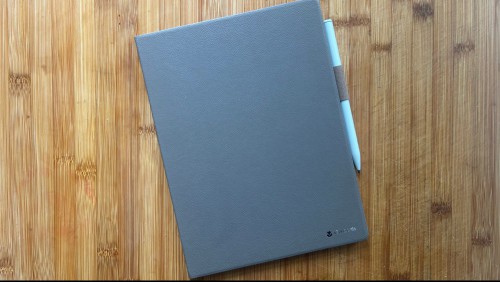
The AiPaper is offered in two sizes; I'm reviewing the larger 10.65-inch version, but there's a smaller 8.2 inch "mini" that has a backlight its bigger brother lacks. The display is the Carta 1300, the most recent e-ink screen and the same one you'll find on a Kindle Paperwhite, which offers a resolution of 2560 x 1920 and 300ppi. Regardless of the name on the device, all e-ink screens are made by the same company and tend to look fairly similar, though the AiPaper does appear a shade or two less gray than comparable devices from Boox and Supernote. The matte screen has a slightly textured quality that makes the writing experience feel pleasantly tactile; it's comparable to writing on a Boox tablet (both use the same EMR styluses, which don't require charging or pairing) but not as paper-like as the reMarkable Paper Pro or Supernote Manta.
The AiPaper is powered by an unspecified 2GHz "octa-core" processor with 4GB or RAM and 128GB of onboard storage, which is on par other e-ink notebooks. The 4,100mAh battery should last about a week with regular use (it definitely seems to be less power-hungry than Boox devices, which I tend to have to charge every three days or so).
At 4.5mm thick and weighing around 370g, it's easily portable without feeling flimsy or insubstantial. There's a power button on top that doubles as a fingerprint scanner for unlocking the device. Along the bottom bezel, there are three touch capacitive buttons: back, home, and "Ai," the latter of which launches the integrated LLM chatbot. And there's a reason Viwoods has given AI such prominence in the design, because in many ways, this digital notebook is all about AI.
Thoughtful AI integration (but you can also just ignore it)
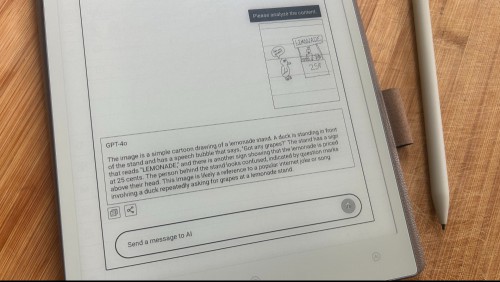
Most digital notebooks have jumped on the AI train, with tablets from Boox and Bigme offering built-in AI chatbots, but the AiPaper goes beyond, weaving AI (which is really just ChatGPT 4o) throughout. You can press the little "Ai" button on the bottom bezel to open up a conversation with ChatGPT, but each app also has an onscreen version of the same button that offers several options:
"Analyze content" sends a screenshot of whatever is onscreen to ChatGPT, which will describe or summarize it.
"Generate an email" will attempt to turn whatever is onscreen into a message that you can then copy into your linked email app of choice with a tap.
"AI text conversion" will turn your handwriting into copyable text and describe any images along the way
"AI assistant" opens the chatbot and attaches a screenshot of whatever is on the display
"Customize" allows you to craft your own frequently used AI prompts so you don't have to type them every time
The answers you get from the chatbot using any of these options can be saved, copied, or sent via QR code, email, Bluetooth, or the cloud using integrated tools.
The AI functionality is what it is—this is just a standard ChatGPT plugin after all—but I'm pretty impressed with the way Viwoods has implemented it. Dropping the AI into every program makes it much simpler to use, assuming you are the kind of person who likes to use AI for everything. (I'm not.) While other notebooks I've reviewed also use ChatGPT, it's mostly just tossed in (the AI button on the Boox Note Max, for example, only offers shape generation and text recognition tools). On the AiPaper, it's easy to incorporate it into your workflow by analyzing and summarizing documents or helping you write.
Of course, this all assumes you want to use AI for any of that. I'm not an AI person, so outside of testing the functionality, I'd pretty much ignore it, and you can certainly do that without missing anything in terms of basic functionality.
Writing and organization
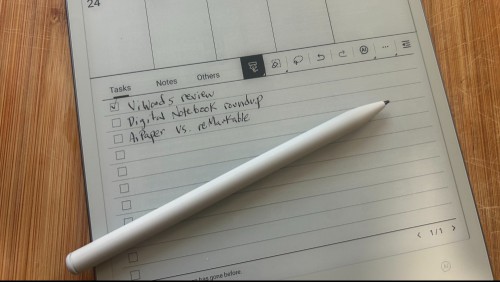
Each e-ink notebook takes its own approach to note-taking and organization, and though I'm a big fan of the Supernote Manta, which sorts everything using tagging and keywords, AiPaper has come up with its own pretty cool system. The home screen is sorted into six sections that organize all your content:
Paper houses your notes and sketches, and its contents can be organized into folders and subfolders.
Daily is a calendar app with built-in note-taking and to-do list features.
Meeting is for organizing and storing notes taken in, uh, meetings.
Learning is the hub where PDFs, EPUBS, and other documents are stored (the device also supports Amazon's MOBI and AZW formats). You can take notes directly into documents opened up in the Learning app, which also supports AI summaries and analysis.
Picking is like a clipping app: If you come across an article you want to save while browsing the internet, you can swipe diagonally from the upper right corner to take a screenshot that you can annotate, analyze with AI, and save for later reference.
Apps obviously houses your apps. Preinstalled options include Mailbox (which works with Gmail, Outlook, Microsoft 365, and a few others), Chrome, OneNote, Kindle, and The New York Times for some reason. You can add more, but you have to jump through some hoops to enable the Google Play store first (the device walks you through it, but it's a little annoying).
Writing on the AiPaper is pretty nice—the stylus feels a little too light and rattles a bit, but I like that it has a button to trigger an eraser function (or you can flip it around and use the opposite end like an eraser on a real pencil). The soft nibs are replaceable and the device comes with two extras that are stored directly in the faux-leather cover, which is a nice touch. You can choose from seven different virtual writing implements, five different line weights, and four shades of grey, making it a viable option for sketching as well.
Stylus problems?
One issue I ran into in my testing was inconsistent response from the stylus—every once in a while, my pen strokes wouldn't register onscreen. I'm not sure if the problem was the stylus nib or the settings (you can adjust how sensitive the screen is to stylus inputs), and the problem was intermittent, but it's something I haven't experienced with other e-ink tablets. It's worth noting that you can use any EMR stylus with the AiPaper, as there's no need to pair the pen with the device, and when testing it out with a Boox stylus, the issue seemed to go away.
A pretty decent e-reader
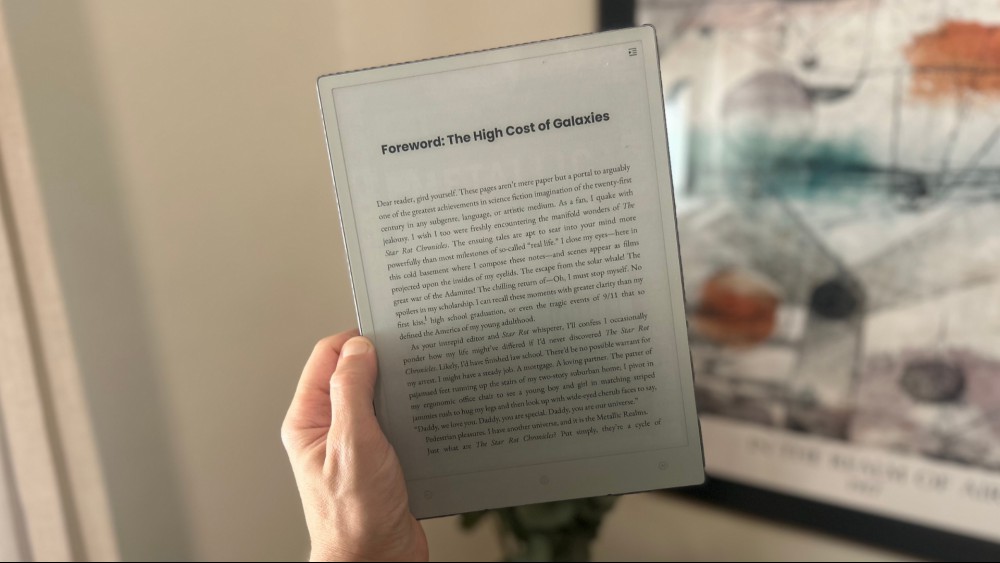
App integration means you can also use the AiPaper as a generic e-reader. You can either load and read EPUBs in the native Learning app or use your reading app of choice. The crisp, responsive screen makes it a pleasant Kindle alternative, and the large display shows off black and white comics and manga quite nicely.
Ghosting issues
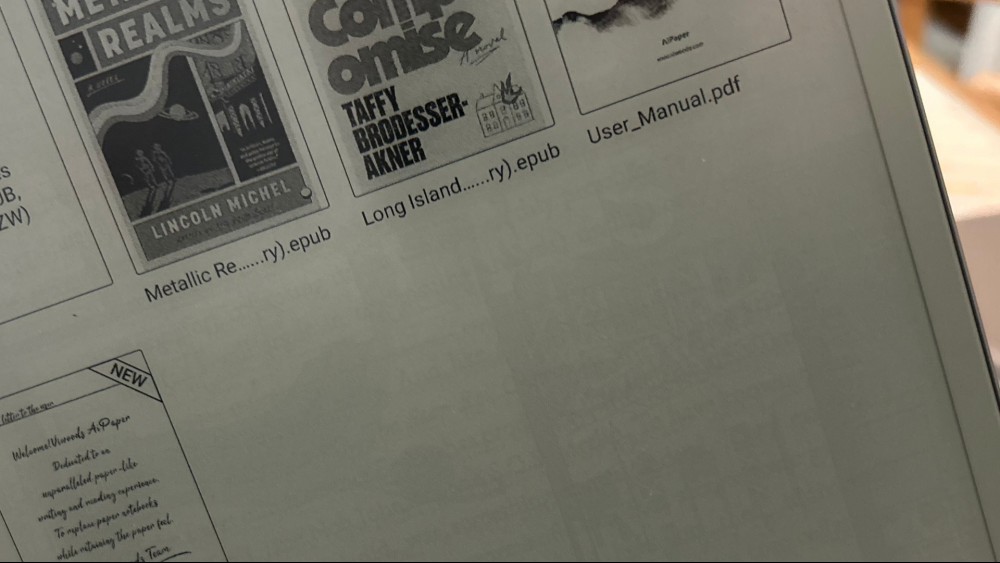
If e-ink has a major drawback, it's ghosting—without belaboring the point, the screens work kind of like an etch-a-sketch, refreshing and rearranging thousands of black pixels to create an image. When the image changes, you can sometimes see a hint of what was there before—this is ghosting.
Like the competition, the AiPaper has various screen refresh modes that allow the display to refresh more quickly based on the kind of content you're looking at, with the faster speeds resulting in more ghosting. But in comparison to the reMarkable and Boox tablets I've tested, the ghosting is more prominent, sometimes visible even in the "best" (i.e., slowest) mode. You can solve for this by swiping down from the top corner of the screen and triggering a manual refresh, but I found myself doing that a lot more often than with some other devices.
"Affordability"
With a retail price of $540 for the tablet, stylus, and a cover (though it's regularly available for closer to $500), the AiPaper costs about the same as the similarly sized Boox Note Air 4C ($530), but is less expensive than the reMarkable 2 ($569) and Supernote Manta ($635 and up, depending on which stylus you choose).
As a niche product, it's on par with the cost of a mid-range iPad and Apple Pencil and can do less, but that's kind of the idea—you shouldn't buy an e-ink notebook unless you want the benefits it provides and are OK with the drawbacks.
An impressive first effort
I've been exploring the e-ink notebook space for about a year now, and most of the chatter in online communities surrounds the familiar players I've been referencing in this review—Boox, reMarkable, and Supernote have all been around for years and have improved their offerings across generations of devices.
That's why I am so impressed with the AiPaper—with its first device, Viwoods had produced a strong competitor to those more established brands. While the Supernote Manta is still my personal pick for the writing feel and the keyword-based organization, I wouldn't push the AiPaper off my desk either. If you're sold on the benefits of working in e-ink, and especially if you're all-in on AI, it's a smart choice.
Covering e-readers, social media, entertainment, and more.
